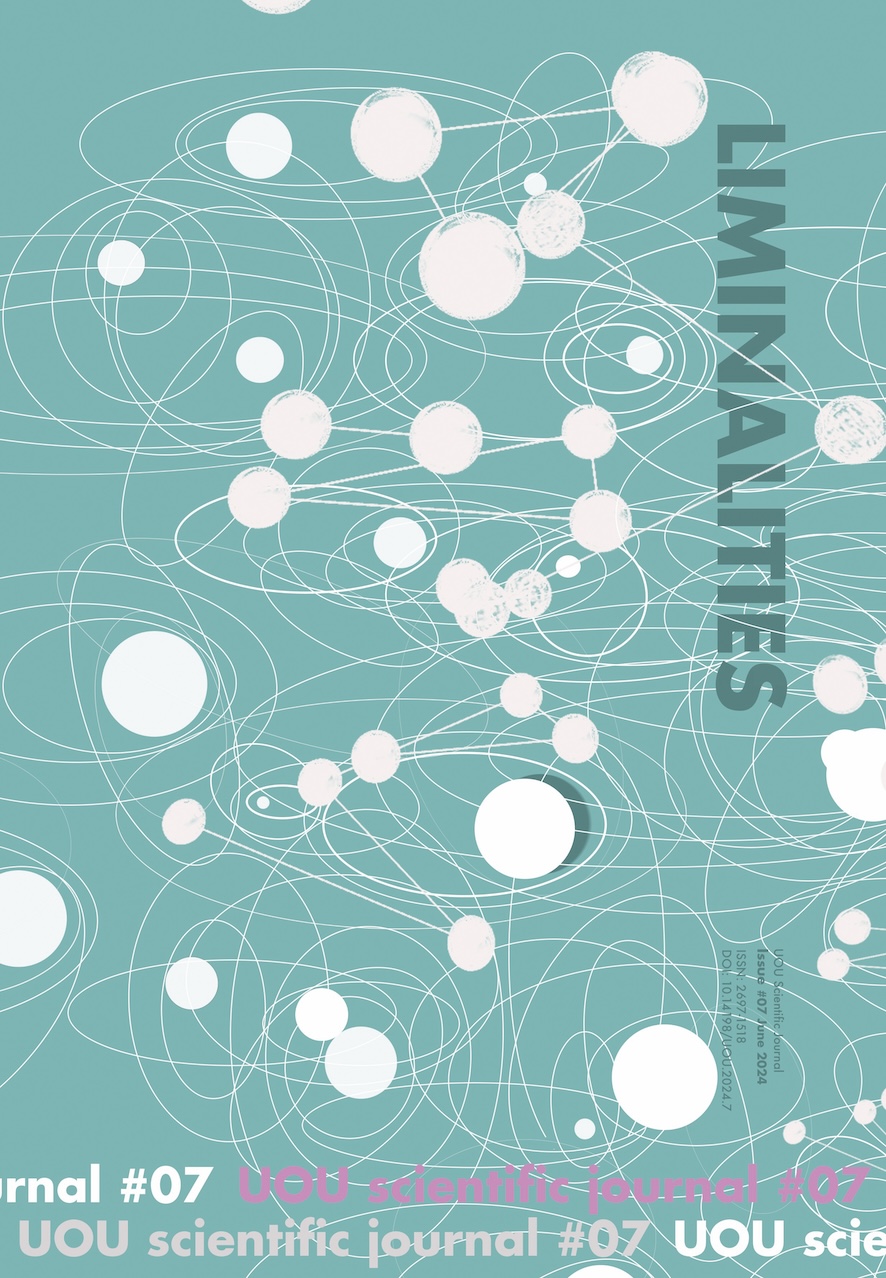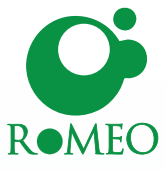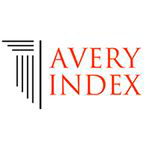CALL UOUsj#7 / LIMINALITIES
 Clarke and Chalmers ask “Where does the mind stop and the world begin?” and speak of “a coupling of biological organism and external resource” proposing that, “once the hegemony of skin and skull is usurped, we may be able to see ourselves more truly as creatures of the world” (Clarke, Chalmers, 1998, 7-18). Malafouris discusses the entanglement of mind and matter, how things“ ‘gather’ space and time” (Malafouris, 2014, 142). He writes “We think ‘with’ and ‘through’ things, not simply ‘about’ things. In that sense, things occupy the middle space in between what are usually referred to as mind and matter” (Malafouris, 2020, 3). He talks of “thinging” as opposed to “thinking”, and writes “Thinging incorporates time-varying and culture-specific bodily techniques; it also extends to sensory and cognitive prostheses and interfaces of any kind” (Malafouris, 2014, 143). A dynamic interacting in a world that is acting upon us.
Clarke and Chalmers ask “Where does the mind stop and the world begin?” and speak of “a coupling of biological organism and external resource” proposing that, “once the hegemony of skin and skull is usurped, we may be able to see ourselves more truly as creatures of the world” (Clarke, Chalmers, 1998, 7-18). Malafouris discusses the entanglement of mind and matter, how things“ ‘gather’ space and time” (Malafouris, 2014, 142). He writes “We think ‘with’ and ‘through’ things, not simply ‘about’ things. In that sense, things occupy the middle space in between what are usually referred to as mind and matter” (Malafouris, 2020, 3). He talks of “thinging” as opposed to “thinking”, and writes “Thinging incorporates time-varying and culture-specific bodily techniques; it also extends to sensory and cognitive prostheses and interfaces of any kind” (Malafouris, 2014, 143). A dynamic interacting in a world that is acting upon us.
Within architecture we are constantly thinking through tools. Tim Ingold further discusses implementations of this entanglement in terms of the design process, he writes:
“In the art of inquiry, the conduct of thought goes along with, and continually answers to, the fluxes and flows of the materials with which we work. These materials think in us, as we think through them. Here, every work is an experiment [...] You try things out and see what happens. Thus the art of inquiry moves forward in real time, along with the lives of those who are touched by it, and with the world to which both it and they belong.” (Ingold, 2013, 6-7)
Our drawings and making extend us into the fictions of spaces yet to be. If we begin to see our models not as something beyond ourselves, but instead employ immersive design practices, might this open up routes to an immersive architecture? Might a knowing implementation offer further potential? Jonathan Hill writes:“A dialogue can exist between what is designed and how it is designed, between design intention and working medium, between thought, action and object – building the drawing rather than drawing the building. [...] In building the drawing, any instrument is a potential drawing tool that can question the techniques of familiar building construction and the assumed linearity of design, so that building and drawing may occur in conjunction rather than sequence.” (Hill, 2005,17)
Might we realise ourselves as participants; part of spatial, design and/or environmental ecologies, bringing situations into being? Through an embrace of our geographical natures might we begin to uncover routes towards analogue and/or digital spatial engagement, that interweaveand entwine rather than divide or simulate; enhancing and extending spatial experience? Through this might we begin to unveil opportunitiesfor immersive interfaces? Might an embrace of our entwined nature draw forward new architectures, new spatial experience? Might it expand our idea of tools and our dialogues with both them, ourselves and our architectures? Might this start to realign how we consider our inhabitation and construction of architectures, or indeed what that word might mean or encompass?
Scope of the issue:
Liminalities sets out to engage our entangled nature, exploring implications across drawing, design, research, education, and architectural space. Authors are encouraged to submit studies, essays, and works through the proposed but not limited topics:
Reflections of entanglement in spatial experience (analogue and/or digital)
- Discourse between virtuality and embodiment (digital and/or analogue).
- Engagement of body/mind and space
Design implications
- Works which engage dynamic interweavings of spaces, times and places.
- Works which employ strategies of spatial
Design processes within an entangled setting
- Methodologies which evolve ways of working, and works that respond to liminalities.
- Dialogic/responsive conversations within designing, drawing and/or making for constructing
References
CLARK, Andy and CHALMERS, David, 1998. The Extended Mind. In: Analysis. Vol. 58, no. 1, pp. 7–19.
HILL, Jonathan, 2005. Building the Drawing. In: Architectural Design. Vol. 75, no. 4, pp. 13–21. DOI 10.1002/ad.98.
IHDE, Don and MALAFOURIS, Lambros, 2019. Homo faber Revisited: Postphenomenology and Material Engagement Theory. In: Philosophy & Technology. Vol. 32, no. 2, pp. 195–214. DOI 10.1007/s13347-018-0321-7.
INGOLD, Tim, 2013. Making: anthropology, archaeology, art and architecture. London; New York: Routledge. ISBN 978-0-415-56722-0.
MALAFOURIS, Lambros, 2014. Creative thinging: The feeling of and for clay. In: Pragmatics & Cognition. Vol. 22, no. 1, pp. 140–158. DOI 10.1075/pc.22.1.08mal.
MALAFOURIS, Lambros, 2020. Thinking as “thinging”: Psychology with things. In: Current Directions in Psychological Science. Vol. 29, no. 1, pp. 3–8. DOI 10.1177/0963721419873349.
About the journal.
UOUsj is the scientific double-blind peer-reviewed journal of UNIVERSITY of Universities and investigates the sharing of intercultural interests explored in international schools of architecture in close connection with the arts. Every issue underlines a specific topic addressed by one of the universities involved in the Research Project. Therefore, we encourage contributions related either to the result of pedagogical experiences and, or, contributions that have emerged from other research in and around the topic of Liminalities in the disciplines of architecture, art, urbanism and associated areas of study.
UOUsj is looking for:
- researchers’ contribution in form of Critical essays and scientific Articles in the section “WRITINGS”.
- artists, practitioners or students contribution in form of Projects that will be included in the section “ATLAS”.
Guest Editors Issue #7
- Charlotte Erckrath, Associate Professor, Bergen School of Architecture / charlotte@bas.org
- Sarah Stevens, Principal Lecturer, University of Brighton / s.stevens2@brighton.ac.uk
Associate Editors Issue #7
- Jerzy Łątka, Wroclaw University of Science and Technology (Poland) / jerzy.latka@pwr.edu.pl
- Joaquín Alvado Bañón, Professor Titular, Alicante University (Spain) / joaquin.alvado4@gmail.com
- Mauricio Morales Beltrán, Yasar University Izmir (Turkey) / mauricio.beltran@yasar.edu.tr
- Michael Devereaux, Associate Professor, University of the West of England (UK) / mike.devereaux@uwe.ac.uk
- Miguel Luengo Angulo, European University Madrid, (Spain) / mleungo@amarillostudio.es
Editor-in-Chief
- Javier Sánchez Merina, Alicante University, Spain
Editorial Director
- Maria Luna Nobile, Umeå University, Sweden
Issue #7/ Submission guidelines.
Articles should be written in standard (UK) English. Only original work will be considered for publication, i.e. work produced by the author/s which has not yet been published elsewhere and which is not currently under review by any other journal or similar academic publication, online or otherwise.
UOUsj accepts manuscripts in different submission types: critical essays and scientific articles. Articles are primarily text based, while students’ project and artistic works are primarily image based.
- Critical Essays should be grounded in relevant discourse, offer an original and critical contribution of a theoretical or a more empirical nature as a response to a research question or proposition and can be supported by appropriate visual apparatus. Length 2,000 - 4,000 words including notes, captions, and references and including the abstract written both in (UK) English and in the mother tongue language.
- Articles should include a consistent focus, clear definition of the research framework, and give a deep understanding of the subject or topic described, including findings, reflections and conclusions. Length 4,000 - 8,000 words including notes, captions, and references and including the abstract written both in English and in the mother tongue language. As a guide, articles should consist of the following sections: Introduction, Background / the-state-of-art, Materials and methods, Results, Discussion and Conclusions.
- Visual Essays, Students’ Projects and Artistic Works should include images, schemes and/or diagrams through an argumentative and not illustrative nature. (Images should be submitted in a A4 PDF format in high resolution (300 dpi) and accompanied by a text as an introductory abstract written both in English and in the mother tongue language of a maximum of 500 words.
Critical Essays and scientific Articles undergo a process of double-blind peer review prior to acceptance for publication. All contributions should be submitted through the online platform of the UOU Journal:
https://revistes.ua.es/uou
Submitted manuscripts should be fully anonymized: remove full name and affiliation; remove references to funding sources; do not include acknowledgements; remove your name from file name; and make sure that document properties have also been anonymized.
Manuscripts should be submitted online in Microsoft Word Format (.docx), and in case of proposals using symbols (e.g. phonetic transcriptions), you are kindly requested to add a PDF version.
Please follow the TEMPLATE.
Login or Register to make a submission.
All the personal information regarding authorship should be provided when registering to make a submission through the platform: title of the manuscript; authorship (author and co-authors); institutional affiliation, full institutional address, including ORCID identifier and e-mail address.
Evaluation of submissions (double-blind peer-reviewed)
To ensure the academic and scientific quality of the publication, all works submitted to UoU journal will be reviewed by the Editorial Team, which will approve its academic quality, as well as its format and publication standards. Editors determine if the works submitted fall within the remit of the journal and ensure compliance with scientific quality standards, verifying:
- The adequacy of the topic to the research lines and aims of the journal and, where appropriate, to the specific theme of a monographic issue proposed for publication.
- Compliance with the formal requirements established in the Guidelines for author’s section.
- The non-commission of plagiarism through the use of specialized software.
Critical essays and scientific articles also undergo a process of double-blind peer review prior to acceptance for publication. The authors will have time to resubmit after amendments if necessary. If the reviewers’ comments have not been addressed, the Essay/Article will not be published.
Reviewers are chosen by the Scientific Board from among experts in the relevant fields of study. They are required to review the manuscript within a month and draft a report by completing a form available on the website. If they disagree on their assessment, a third evaluator will be sent the manuscript, which will be anonymous throughout the whole process.
After receiving the assessment reports, the general editors will inform the author that one of the following statuses has been assigned to the manuscript:
- Accepted.
- Accepted with modifications. The manuscript will be published only if the authors introduce the changes proposed by the reviewers within two weeks.
- New assessment required. The manuscript is not yet suitable for publication, but the Editorial Board will allow the authors to rewrite it and make any proposed changes in approach within three weeks. Upon receipt of the revised article, the Editorial Board will decide whether the new version can be published or should be assessed again by external evaluators.
- Not accepted.
After the assessment process a proof of the article will be sent to the author, who may propose non-content-related changes within seven days. Once the final version is ready, the article will be available on the journal’s website.
For any information on the call, you can contact the Guest Editors, Charlotte Erckrath / charlotte@bas.org
and Sarah Stevens / s.stevens2@brighton.ac.uk
Detailed guidelines are available on the UOUsj website: https://revistes.ua.es/uou












